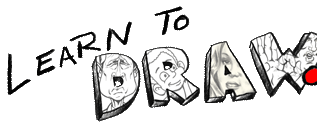It's quite common when figure drawing that your
subject's head will be at an odd angle. Not too often is
your subject looking straight at you. The proportions
and perspective that you see when the face is looking
straight at you get blown out of the water when the head
moves to an angled position. You won't be able to rely
on standard proportions so you'll have to for sure draw
what you see, and not what your logical mind tells you
what is there. There are, however, some things that you
can keep in mind when drawing an angled head to make it
easier on you.
When the head is looking Downward:
 You'll
see more forehead and top of the head than chin or
bottom of the face. You'll
see more forehead and top of the head than chin or
bottom of the face.
 The
ears appear to be higher up on the head than they
actually are. The
ears appear to be higher up on the head than they
actually are.
 You
can draw an imaginary vertical line that bisects the
face. As the face turns, that line will turn with the
face and become a sharper arc as the head turns. You
can draw an imaginary vertical line that bisects the
face. As the face turns, that line will turn with the
face and become a sharper arc as the head turns.
 The
nose appears to be longer and lower on the face than it
actually is. The
nose appears to be longer and lower on the face than it
actually is.
 Since
the face is not a flat plane, but a curved surface, you
can draw an imaginary horizontal line through the eyes
and mouth. The more the head turns down, the more the
imaginary horizontal line arcs upward. Since
the face is not a flat plane, but a curved surface, you
can draw an imaginary horizontal line through the eyes
and mouth. The more the head turns down, the more the
imaginary horizontal line arcs upward. When the
head is looking Upward:
 You'll
see more chin, neck, and bottom of the chin than brow or
forehead. You'll
see more chin, neck, and bottom of the chin than brow or
forehead.
 The
ears appear to be lower on the head than they actually
are. The
ears appear to be lower on the head than they actually
are.
 You
can draw an imaginary vertical line that bisects the
face. As the face turns, that line will turn with the
face and become a sharper arc as the head turns. You
can draw an imaginary vertical line that bisects the
face. As the face turns, that line will turn with the
face and become a sharper arc as the head turns.
 The
nose appears to be shorter and higher on the face than
it actually is. The nose can be see as a triangular
shape. The
nose appears to be shorter and higher on the face than
it actually is. The nose can be see as a triangular
shape.
 Since
the face is not a flat plane, but a curved surface, you
can draw an imaginary horizontal line through the eyes
and mouth. The more the head turns up, the more the
imaginary horizontal line arcs downward. These imaginary
horizontal lines will help you to place the eyes and
mouth. Since
the face is not a flat plane, but a curved surface, you
can draw an imaginary horizontal line through the eyes
and mouth. The more the head turns up, the more the
imaginary horizontal line arcs downward. These imaginary
horizontal lines will help you to place the eyes and
mouth. Each image below is clickable so you can get a
better look at it. I drew the head in blue, and drew the
construction line bisecting the face and the lines
across the eyes and mouth in pencil.
When you draw an angled head watch very closely what
you are doing and measure your subject often. Because
"normal" proportion gets thrown out the window, you'll
have to rely on measuring one element against another
element in order to create the angled head correctly.
When the subject has a lot of hair, it makes the drawing
that much harder because you can't see the scalp, and so
you'll have to guess where the scalp is under all that
hair. Finding the scalp will aid you a lot in finding
correct proportions to the head.
 To
draw an angled head, draw an oval as close to your
subject's head shape as you can, then bisect the oval
vertically. Then draw the two arced lines representing
the eyes and nose. Measure what you've drawn, and if
anything is off, erase and draw again the part that is
incorrect. Then draw in the features on the face. If you
need some instruction on drawing the features of the
face, check out the
Drawing Portraits tutorials. To
draw an angled head, draw an oval as close to your
subject's head shape as you can, then bisect the oval
vertically. Then draw the two arced lines representing
the eyes and nose. Measure what you've drawn, and if
anything is off, erase and draw again the part that is
incorrect. Then draw in the features on the face. If you
need some instruction on drawing the features of the
face, check out the
Drawing Portraits tutorials.
|
